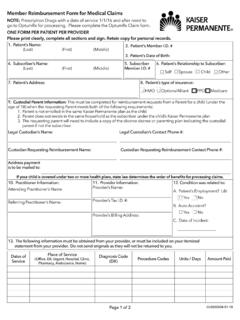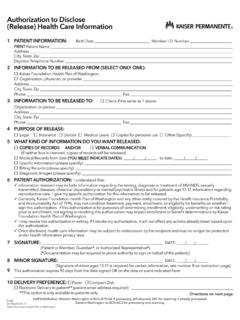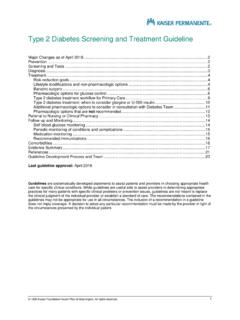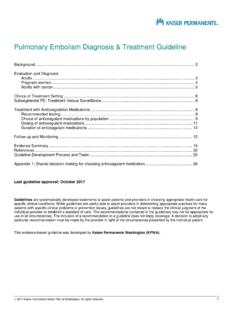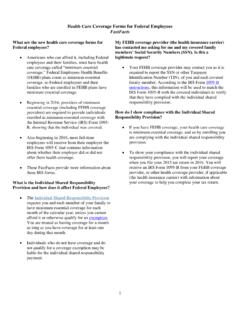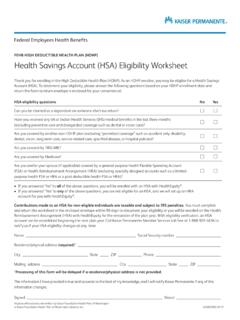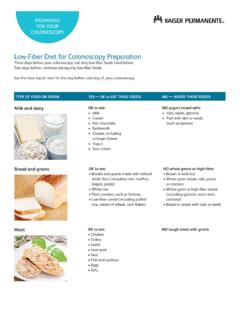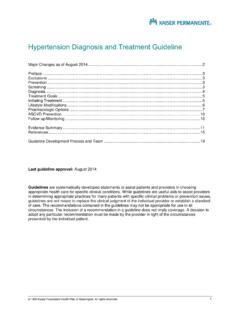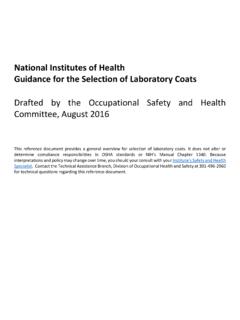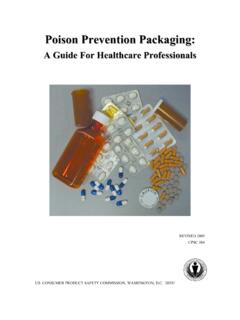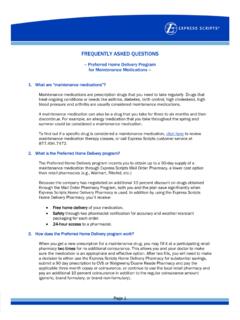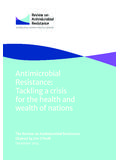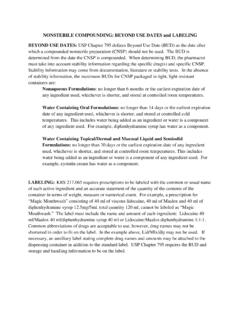Transcription of Living with MRSA - Kaiser Permanente
1 Living with MRSAL earning how to control the spread of Methicillin- resistant Staphylococcus Aureus (MRSA)This is really serious. I need to do something about this now!I M P O R TA N TMRSA is a serious infection that can become life-threatening if left untreated. If you or someone in your family has been diagnosed with MRSA, there are steps you need to take now to avoid spreading it to your family and friends. This booklet was developed with help from people who are Living with MRSA. Follow the recommendations and practice good hygiene to take care of yourself. MRSA may cause physical pain and emotional stress, but keep in mind that it can be managed.
2 This booklet tells you how you can live with MRSA. C o n t e n t s Learning About MRsA Page 2 What is MRsA and why is it so serious? 2 What does MRsA look like? 3 How did I get MRsA? 4 Will I always have MRsA? 4 How contagious am I? 4 Is there a test for MRsA? 5 If I have MRsA, do I need to do anything special when I go to a clinic or hospital? treating MRsA 6 How is MRsA treated? 7 When should I seek medical care? Caring for Yourself 8 Does it matter how I wash my hands? 9 Do I need to be careful when I do laundry? 0 What about cleaning my house? How do I change my bandages?
3 3 Personal Care Guidelines Controlling MRsA 4 How do I stop MRsA from spreading when I have an active infection? 5 How do I stop MRsA from spreading when I m a carrier? 5 Children and MRsA 5 Pets and MRsA Resources 6 shopping List 6 Web sites2 What is MRsA and why is it so serious?Some germs that commonly live on the skin and in the nose are called staphylococcus or staph bacteria. Usually, staph bacteria don t cause any harm. However, sometimes they get inside the body through a break in the skin and cause an infection. These infections are usually treated with antibiotics.
4 When common antibiotics don t kill the staph bacteria, it means the bacteria have become resistant to those antibiotics. This type of staph is called MRSA (Methicillin- resistant Staphylococcus Aureus). Anyone can get MRSA. Infections range from mild to very serious, even life-threatening. MRSA is contagious and can be spread to other people through skin-to-skin contact. If one person in a family is infected with MRSA, the rest of the family may get was first identified in the 1960 s and was mainly found in hospitals and nursing homes. This occurred because antibiotics were being given to people when they weren t needed, and patients were not taking antibiotics as directed.
5 In the late 1990 s, a new type of MRSA was identified. This type of MRSA is becoming more common among children and adults who do not have medical does MRsA look like?Most often, MRSA causes infections on the skin. These infections may look like any one of the following: Sores that look and feel like spider bites (However, MRSA is not caused by a spider bite.) Large, red, painful bumps under the skin (called boils) A cut that is swollen, hot and filled with pus Blisters filled with fluid (called impetigo)It is also possible to have MRSA in other areas of the body, such as blood, lungs, eyes, and urine.
6 These types of infections are less common, although often more serious. Because skin infections are more common, this booklet will focus on them. L e A Rn I n G A b o u t M RsA3 How did I get MRsA?Anyone can get MRSA. You can get MRSA the same way you can get a cold, such as by touching someone or something that has the bacteria on it and then touching your eyes or your nose. Washing your hands often reduces your chances of getting can live on surfaces and objects for months. However, it can be killed though proper cleaning methods. (Go to the section on Caring for Yourself on page 10 to learn more about cleaning.)
7 Some ways that you could get MRSA: Touching the infected skin of someonewho has MRSA Using personal items of someone whohas MRSA, such as towels, wash cloths,clothes or athletic equipment Touching objects, such as publicphones or doorknobs, that have MRSA bacteria on the surface Being in crowded places where germsare easily spread, such as hospitals,nursing homes, daycares or collegedormsYou may increase your chances of getting MRSA if: You take antibiotics a lot You take antibiotics without aprescription You don t follow directions when takingantibiotics, such as stopping early ormissing dosesYou are at greater risk of getting MRSA if you are recovering from surgery or burns, have tubes in your body for medical treatment, or if you share are two ways you can have MRsA.
8 You can have anactive active infection meansyou have symptoms. thetypes of symptoms dependon where the bacteriaare located. usually anactive infection is a skininfection, such as a boil, asore, or an infected You can be a you are a carrier you donot have symptoms thatyou can see, but you stillhave MRsA bacteria livingon your skin and in yournose. If you are a carrier,your provider may say thatyou are colonized. thesewords carrier and colonized mean thesame e A Rn I n G A b o u t M RsA4 Will I always have MRsA?Maybe. Many people who have active infections are treated and no longer have MRSA.
9 However, sometimes MRSA goes away after treatment and comes back several times. If MRSA infections keep coming back again and again, your health care provider can help you sort out the reasons you keep getting if active infections go away, you can still have MRSA bacteria on your skin and in your nose. This means you are now a carrier of MRSA. You may not get sick or have any more skin infections, but you can spread MRSA to others. It is not fully understood why some people are carriers of MRSA, yet don t get infections. How contagious am I?If you have an active MRSA infection on your skin, it is contagious.
10 If someone touches your infections, or touches something that came in contact with your infections (like a towel), that person could get you are a MRSA carrier, you still have the bacteria on your skin and in your nose. If you don t wash your hands properly, things that you use or touch with your hands can give the bacteria to other people. MRSA can also be found in the liquid that comes out of your nose or mouth when you cough or , if you have MRSA it is possible to spread it to family, friends, other people close to you, and even to pets. Washing your hands and preventing others from coming in contact with your infections are the best ways to avoid spreading there a test for MRsA?
